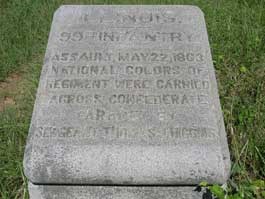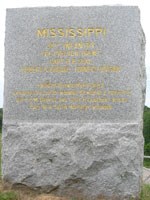
NPS Photo The physical characteristics of the stone determine which methods are used. A high-pressure water spray is usually the first step in removing dirt, grime, and surface contaminants. The water can be applied hot or cold, under high or low pressure, but it may require protective clothing and safety equipment. 
NPS Photo Gold leaf has also been used to enhance etchings on several of the granite monuments and regimental markers in the park. The Texas state monument and those of the Mississippi units (CSA) were very difficult to read from their initial construction. Gilding the inscriptions has clearly defined the monuments’ text and has vastly improved the visitors’ experience as they travel the park tour road. Park monuments are located throughout the 1,800-acre battlefield — some points very accessible, some not. Whether situated on a hilltop or at the bottom of the ravine, monuments must be easily reached for preservation treatments to occur. This requires the use of equipment which is portable, durable, and can be easily moved to within close proximity of the structures. |
Last updated: April 14, 2015
